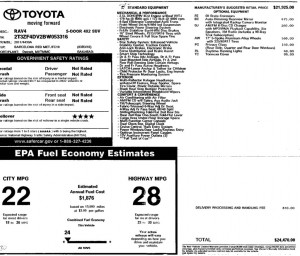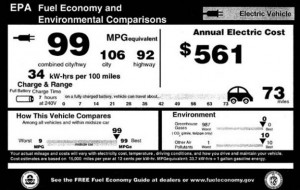
A recent study shows that consumers don't have much faith in the mileage ratings on new vehicle window stickers.
With the number of times automakers have had to restate the fuel economy figures for new vehicles, it’s no wonder a recent study finds Americans are skeptical about the mileage numbers slapped on the window stickers of new cars and trucks.
However, the reason for skepticism is a bit surprising: a substantial number of buyers doubt the reported numbers because their personal vehicles outperform the figures on the official fuel-economy labels.
A new AAA survey indicated that a third of Americans do not believe the U.S. Environmental Protection Agency’s (EPA) new vehicle window sticker accurately reflects the fuel economy they achieve when driving.
Consumer advocates have complained for years the EPA fuel economy tests, which are performed in a laboratory-like setting rather than on public streets, don’t accurately reflect the rear-world performance of vehicles. Indeed, EPA itself has cracked down on various automakers, most notably Hyundai, for submitting questionable data. Other automakers, such as Ford, have been forced to restate their fuel-economy claims of certain vehicles.

The mileage ratings for electric vehicles, like the Nissan Leaf and its 99 MPGe rating, still confuses some consumers, according to a recent study.
The situation is further complicated by the fact the fuel-economy numbers of battery electric are calculated using a mathematical formula that translates the battery usage into the fuel-economy numbers of gasoline powered vehicle.
However, AAA analyzed data collected on the EPA’s FuelEconomy.gov website, along with laboratory and real-world vehicle testing, and found that driver behaviors and environmental conditions, rather than vehicle shortcomings, are likely responsible for most fuel economy variances.
“For years, we’ve heard that drivers question whether the fuel economy rating for their vehicle is accurate,” said John Nielsen, AAA’s managing director, Automotive Engineering and Repair. “In the interest of our members, AAA aimed to address this issue with a multi-phase testing series designed to uncover the real reasons behind fuel economy variations.”
AAA engineers conducted a comprehensive analysis of 37,000 records submitted to the EPA, representing over 8,400 vehicle make, model and year combinations, to identify trends in real-world fuel economy. Surprisingly, among the self-reported data, eight out of 10 drivers reported fuel economy that was higher than the combined city and highway EPA mileage rating for their vehicle, according to AAA.
Owners of certain categories of engines, such as powertrains with manual transmissions, diesel and big V8 engines found in trucks, all self-reported better fuel-economy numbers that those automakers reported to the EPA.
For example, owners of vehicles equipped with manual transmissions reported 17% higher fuel economy than EPA ratings. The owners of diesel-fuel vehicles, including light trucks, reported 20% higher fuel economy.
Meanwhile ruck owners with gasoline-fuel V-8 engines reported fuel economy 5% higher than EPA ratings, while owners of turbocharged V-6 engines reported fuel economy that was 9% lower.
“The vast majority of drivers that submit their vehicle’s fuel economy to the EPA report mileage that beats the window sticker rating,” continued Nielsen. “Although self-reported data has limitations, it’s encouraging to see real-world fuel economy that more closely aligns with, or even exceeds, automaker promises.”
In conducting the analysis, AAA engineers identified a list of vehicles that were frequently reported as failing to achieve the EPA’s mileage rating. The majority of these vehicles, including the scrutinized Hyundai and Kia models, have since been retested and, in some cases, mileage ratings were revised. AAA selected three additional vehicles – a 2014 full-size pickup truck, a 2014 large sedan and a 2012 medium sedan – for further testing.
(Toyota adds 1.37 million vehicles to its Takata airbag recall. For more, Click Here.)
In partnership with the Automobile Club of Southern California’s Automotive Research Center, AAA tested the vehicles independently to verify the fuel economy. Over the course of several weeks, testing was conducted using a certified dynamometer and on the streets of Southern California. Test results from of all three vehicles confirmed the EPA mileage rating was accurate, leaving AAA to conclude that driving behaviors, vehicle condition, driving environment and terrain are likely responsible for most deviations from EPA ratings that consumers experience.
“In addition to logging hundreds of miles in various driving environments, the research team put the vehicles through EPA-specified testing designed to mimic the real-world conditions, including city, highway and aggressive driving,” said Megan McKernan, manager of the Automobile Club of Southern California’s Automotive Research Center.
(Click Here for details the return of the Fisker Karma.)
“The findings indicate that while vehicles tested are capable of achieving the EPA rating, a driver’s real-world mileage will vary based on driving style.”
In the next phase of AAA’s fuel economy testing series, to be released in late 2015, researchers will measure the impact that specific driving behaviors, such as acceleration rates and idle time, have on an individual driver’s fuel economy. In the meantime, AAA recommends that drivers take a closer look at their driving habits to understand the role they play in the fuel efficiency of their vehicle.
(To see more about Nevada’s new “electric highway,” Click Here.)
“If you drive aggressively, with heavy acceleration, hard braking and driving at higher speeds, your fuel economy is going to suffer,” Nielsen said. “Driving just five miles-per-hour above 50 is like paying an additional 19 cents per gallon for gasoline.”

Numerous tests have shown that mpg can vary by as much as 30% exclusively on driving style. When you enter terrain and climatic conditions into the mix you can get a lot of deviation from a theoretical test developed by the EPA to use as a reference only. Unfortunately the folks who get lower mpg think the EPA ratings are false claims because they lack the technical knowledge to understand that their personal driving style has a drastic impact on the results.
I don’t see anyone suing the EPA for mpg numbers that are too low… but I’m sure someone will try if they can get Jackpot Justice.
U.S. Diesel EPA test results are all intentionally lower than the actual results people obtain with Diesel engines. Obama and the EPA should be sued for intentionally deflating the clean Diesel mpg to mislead and discourage consumers from purchasing high mpg, clean Diesels like the rest of the world uses. It’s just one more example of bad government duping the public to promote impractical EVs…and it’s criminal fraud IMO. VW proved that their U.S. spec clean Diesels delivered far better mpg in actual use that the EPA test results.
The problem with EPA numbers is everyone, including the President of the USA uses these number to what they want them to be. They’ll boost that we need to increase the MPG to get legislation passed for more stringent rules or use them to say “look what we have done to reduce the carbon footprint”.
It is time to revamp the EPA MPG tests. Questions that why we need a change!
1) At what speed is used for HWY
2) At what ambient temperature
3) At what altitude
and dozen of other variables.
The current system is only used to see if the manufactures are meeting the EPA guidelines. Nothing more.
Since diesel under-performance was evident under former President Bush/Cheney, sue them. But the real problem is somewhere in the numbers VW submits.
BTW, we drive both a 2003 and 2010 Prius and consistently beat EPA numbers. In 2009, a diesel advocacy, advertising company drove a Prius and Jetta TDI only to discover they got within 1 MPG over the 7,000 miles.
Whenever a ‘driving style’ advocate wants to show off the superiority of their methods, you’ll find them in a Prius.
Bob Wilson, Huntsville, AL
Headline news: Variables make things vary